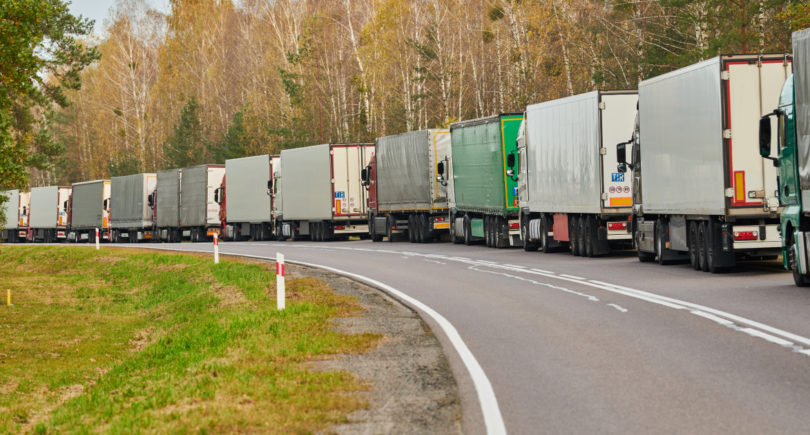
Opinions Infrastructure Ukrzaliznytsia 1516 14 March 2023
The solution to the problem of insufficient capacity of the western railway crossings will not be fast
With the beginning of military aggression against our country and the blocking of seaports, the main challenge for the transport system of Ukraine was the reorientation of export cargo flows from Ukrainian ports to the direction of the western border crossings. This led to the emergence in 2022 of a number of problems in the field of railway logistics, which were not resolved during the year of the war.
Infrastructural insolvency
Before the war, Ukrainian ports annually handled about 160 million tons of cargo, while almost 120 million tons of cargo was exported through the ports. In this context, Ukrainian Railways (UZ) faced the problem of limited capacity of land border crossings operating in the west. Their capacity does not allow to physically process the export flow that previously moved through seaports. The existing 13 border railway crossings can theoretically pass 3,422 wagons or approximately 220,000 tons of cargo daily. This is almost 6.6 million tons per month or 80 million tons per year.
In fact, the western railway crossings in 2022 passed only 3-3.6 million tons of cargo per month, that is, they worked at 55% of their capacity. And the reason is not the capacity of the crossings, but the ability of the European transport system to receive these goods. Unfortunately, the transport system of Europe is not yet able to do this due to the lack of additional port facilities, the limited capacity of the railways of countries neighboring Ukraine, the lack of rolling stock and other reasons.
Amid this, the problems of various sectors of the Ukrainian economy in terms of exporting products have become aggravated due to the existing railway border crossings.
Ukrainian Railways faced pressure from exporters, who demanded that their cargoes be passed through in the first place. The most active in this process were exporters of agricultural products due to the fact that before the war, almost 95% of agricultural products were exported through seaports. The agricultural sector is one of the most affected sectors of the country’s economy. Also, thanks to the active position of the Ministry of Agrarian Policy, the voice of agrarians was heard and they began to actively develop a new direction for grain exports – export through western railway crossings and automobile crossings. Farmers quickly adapted to the current export conditions, and grain is currently exported through 12 out of 13 existing railway border crossings. Agrarians do not work only because of the Rawa-Ruska – Werhrata (Poland) crossing.
A big victory for Ukrainian farmers was the conclusion of the grain agreement in July 2022. This allowed the farmers to reach the pre-war volumes of grain exports in autumn, although at the same time the farmers received a cardinal rise in the cost of logistics.
Lines at the border
The accumulation of wagons moving towards the western borders led to the appearance of queues. First, you need to understand that when planning transportation, Ukrainian Railways necessarily coordinates the loading volumes with the recipients of the cargo (with foreign carriers, ports, port operators and other recipients).
That is, each loaded wagon was previously agreed with the recipient of the cargo. In addition, when planning transportation in the planning program of Mesplan, a number of logical controls are set (on the processing capacity of stations, terminals, etc.), which will not allow planning a larger volume than the station, crossing, terminal physically process.
Problems arise when the recipient (for example, a foreign carrier) begins to negotiate more volumes than it is physically able to accept. In this case, UZ acts as an administrator of the planning process.
In the EU, the rail transport market is deregulated; several foreign carriers operate at one border junction, competing with each other for Ukrainian cargo and limited crossing capacity.
Long term planning
In this regard, the question of the need for long-term planning for the transport of goods through the western border crossings often arises. For Ukrainian Railways, as a carrier, the introduction of long-term planning means an increase in efficiency. Long-term planning will allow UZ to qualitatively plan the provision of transportation with locomotive traction, plan the supply of wagons, distribute the loading of individual sections, that is, qualitatively and efficiently distribute the available resources.
But how will this affect the supply chains of our exporters? Are they able to plan their work with a horizon of more than one month? In conditions when the price of export products is constantly changing and you have a choice where to take grain for export – to Ukrainian ports or the port of Constanta (Romania), or Gdansk (Poland)? And most importantly, are all participants in the export logistics chain able to work in a long-term planning environment? Let’s look at the example of grain exports.
In my personal opinion, with the actual organization of grain transportation for export through border crossings, it is impossible to qualitatively plan transportation with a horizon of more than one month.
Firstly, the port operator in the ports of Constanta or Gdansk needs to know the dates of arrivals of vessels for loading a certain batch, the terminal needs to plan its work – the availability of free storage capacity for the accumulation of a ship batch, take into account the capacity of unloading equipment, coordinate the acceptance of threads with the railway and the volumes of unloading/receiving grain and so on.
Secondly, a foreign railway carrier should coordinate the acceptance of cargo/railcars at the border with UZ, agree on the calendar and volumes of grain transshipment from a 1520 mm gauge wagon to a 1435 mm gauge wagon with the border terminal, and also agree on the volume and calendar of delivery of cargo with the port terminal.
That is, to coordinate and plan work with three participants in the transportation process. After that, the foreign carrier needs to calculate the internal need for carriage and locomotive support, as well as coordinate the movement of trains on the network with the infrastructure operator (purchase the threads of the schedule). That is, in fact, this planning process is qualitatively possible to carry out only in the horizon of one month.
Therefore, the possible changes do not improve or increase the overall capacity of the border crossings, but only redistribute the scarce capacity between individual companies.
This issue should be discussed in a wider circle, with the involvement of other industries: builders, mining, cement industry, oil and fat, etc. By holding public discussions and calculating the consequences, we can implement long-term planning in export transportation.
There is an option – launching a pilot project in which we will try to provide an opportunity to plan in the long term 30% of the available capacity of the transition, while exporters from different industries and willing foreign carriers should participate. Based on the results of the pilot project, it is necessary to make a decision on the introduction of long-term planning.
If shippers really want to speed up the process of agreeing on loading plans and make it transparent, it is necessary to require their foreign carriers (employers) and border terminals (they work with) to join the Mesplan planning program. This will make it possible to coordinate all applications in electronic form and to attach to planning all participants in the logistics chain at the border with a foreign carrier, a transshipment terminal/recipient.




